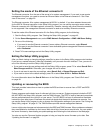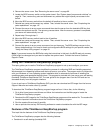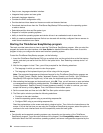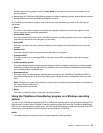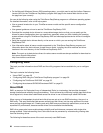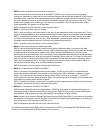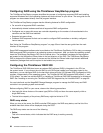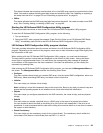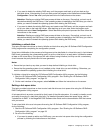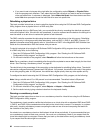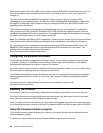
This status indicates that more than one hard disk drive in the RAID array cannot be synchronized or have
failed. You need to replace the failing hard disk drives and rebuild the data. See “Installing or replacing a
hot-swap hard disk drive” on page 122 and “Rebuilding a physical drive” on page 62.
• Ofine
This status indicates that the RAID array has failed and cannot be rebuilt. You need to create a new RAID
array. See “Creating, adding, or deleting a RAID array” on page 60.
Starting the LSI Software RAID Conguration Utility program
This topic provides instructions on how to start the LSI Software RAID Conguration Utility program.
To start the LSI Software RAID Conguration Utility program, do the following:
1. Turn on the server.
2. During the POST, when you see the message “Press Ctrl-M or Enter to run LSI Software RAID Setup
Utility,” immediately press Ctrl+M to start the LSI Software RAID Conguration Utility program.
LSI Software RAID Conguration Utility program interface
This topic provides information about the menus and items in the LSI Software RAID Conguration Utility
program. Depending on the version of the program, some menu or item information might differ slightly from
the information in this topic.
When working with the LSI Software RAID Conguration Utility program, you must use the keyboard.
The keys used to perform various tasks are displayed on the bottom of each screen. Use up and down
arrow keys to navigate between items. For most items, the corresponding help message is displayed
on the bottom of the screen when the item is selected. If the item has submenus, you can display the
submenus by pressing Enter.
After entering the LSI Software RAID Conguration Utility program, you can see the Management Menu on
the screen. The Management Menu contains the following menu items:
• Congure
This menu contains items to help you create a RAID array, view the current RAID conguration, add a new
RAID array, delete an existing RAID array, and select a boot virtual drive.
• Initialize
This menu helps you initialize virtual drive(s).
Note: Initializing a virtual drive erases all data on the virtual drive. Back up any data you want to keep and
ensure that the operating system is not installed on the virtual drive before the initialization.
• Objects
This menu helps you congure parameters for the RAID controller, the virtual drive(s), and the physical
drive(s).
• Rebuild
This menu helps you rebuild a physical drive in a RAID array in the event of a physical drive failure.
You can choose to rebuild the data on the failing drive if the drive is still operational. If the drive is not
operational, it must be replaced and the data on the failing drive must be rebuilt on a new drive to restore
the system to fault tolerance.
• Check Consistency
This menu helps you do consistency check for the virtual drive(s). The consistency check veries the
correctness of the data on virtual drive(s) that use RAID 1, 5, and 10.
Chapter 5. Conguring the server 59



